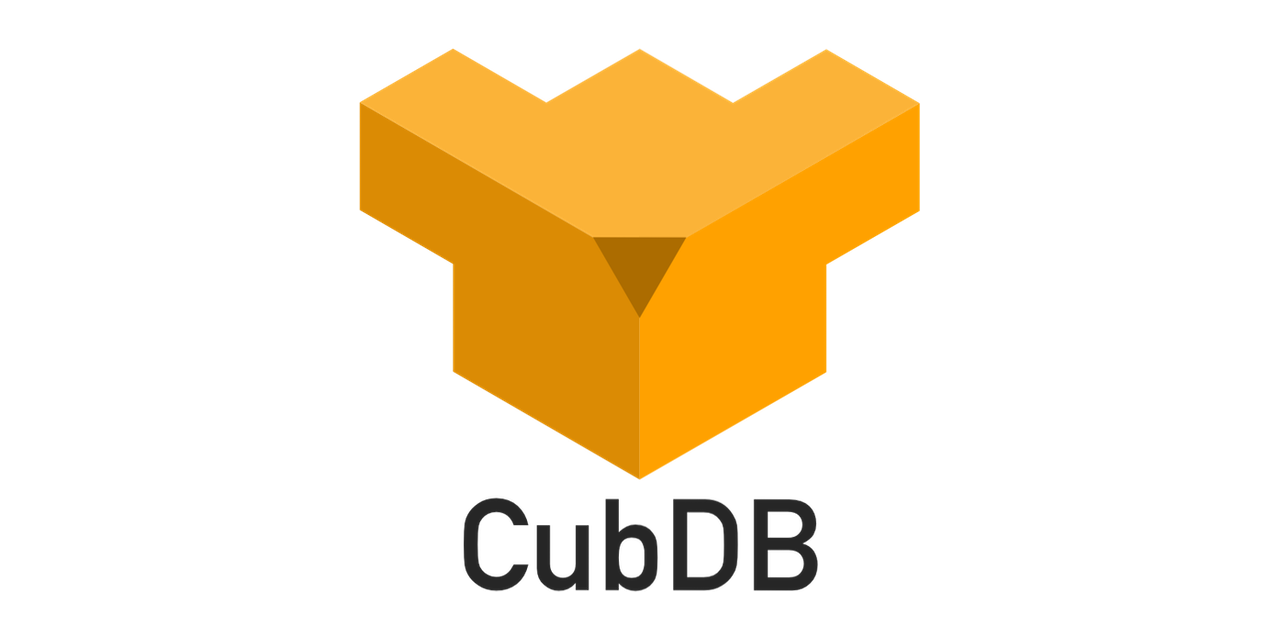CubDB is an embedded key-value database for the Elixir language. It is
designed for robustness, and for minimal need of resources.
Head to the API reference for usage details, or read the Frequently Asked Questions and the How To section for more information.
-
Both keys and values can be any Elixir (or Erlang) term.
-
Basic
get,put, anddeleteoperations, selection of ranges of entries sorted by key withselect. -
Atomic, Consistent, Isolated, Durable (ACID) transactions.
-
Multi version concurrency control (MVCC) allowing concurrent read operations, that do not block nor are blocked by writes.
-
Unexpected shutdowns or crashes won't corrupt the database or break atomicity of transactions.
-
Manual or automatic compaction to reclaim disk space.
To ensure consistency, performance, and robustness to data corruption, CubDB
database file uses an append-only, immutable B-tree data structure. Entries are
never changed in-place, and read operations are performed on zero cost immutable
snapshots.
Start CubDB by specifying a directory for its database file (if not existing,
it will be created):
{:ok, db} = CubDB.start_link(data_dir: "my/data/directory")Avoid starting multiple
CubDBprocesses on the same data directory. Only oneCubDBprocess should use a specific data directory at any time.
get, put, and delete operations work as you probably expect:
CubDB.put(db, :foo, "some value")
#=> :ok
CubDB.get(db, :foo)
#=> "some value"
CubDB.delete(db, :foo)
#=> :ok
CubDB.get(db, :foo)
#=> nilMultiple operations can be performed atomically with the transaction function
and the CubDB.Tx module:
# Swapping `:a` and `:b` atomically:
CubDB.transaction(db, fn tx ->
a = CubDB.Tx.get(tx, :a)
b = CubDB.Tx.get(tx, :b)
tx = CubDB.Tx.put(tx, :a, b)
tx = CubDB.Tx.put(tx, :b, a)
{:commit, tx, :ok}
end)
#=> :okAlternatively, it is possible to use put_multi, delete_multi, and the other
[...]_multi functions, which also guarantee atomicity:
CubDB.put_multi(db, [a: 1, b: 2, c: 3, d: 4, e: 5, f: 6, g: 7, h: 8])
#=> :okRange of entries sorted by key are retrieved using select:
CubDB.select(db, min_key: :b, max_key: :e) |> Enum.to_list()
#=> [b: 2, c: 3, d: 4, e: 5]The select function can select entries in normal or reverse order, and returns
a lazy stream, so one can use functions in the Stream and Enum modules to
map, filter, and transform the result, only fetching from the database the
relevant entries:
# Take the sum of the last 3 even values:
CubDB.select(db, reverse: true) # select entries in reverse order
|> Stream.map(fn {_key, value} -> value end) # discard the key and keep only the value
|> Stream.filter(fn value -> is_integer(value) && Integer.is_even(value) end) # filter only even integers
|> Stream.take(3) # take the first 3 values
|> Enum.sum() # sum the values
#=> 18Read-only snapshots are useful when one needs to perform several reads or selects, ensuring isolation from concurrent writes, but without blocking them. When nothing needs to be written, using a snapshot is preferable to using a transaction, because it will not block writes.
Snapshots come at no cost: nothing is actually copied or written on disk or in
memory, apart from some small internal bookkeeping. After obtaining a snapshot
with with_snapshot, one can read from it using the functions in the
CubDB.Snapshot module:
# the key of y depends on the value of x, so we ensure consistency by getting
# both entries from the same snapshot, isolating from the effects of concurrent
# writes
{x, y} = CubDB.with_snapshot(db, fn snap ->
x = CubDB.Snapshot.get(snap, :x)
y = CubDB.Snapshot.get(snap, x)
{x, y}
end)The functions that read multiple entries like get_multi, select, etc. are
internally using a snapshot, so they always ensure consistency and isolation
from concurrent writes, implementing multi version concurrency control (MVCC).
For more details, read the API documentation.
CubDB can be installed by adding :cubdb to your list of dependencies in
mix.exs:
def deps do
[
{:cubdb, "~> 2.0.2"}
]
endThe file data structure used by CubDB is inspired by
CouchDB. A big thanks goes to the CouchDB
maintainers for the readable codebase and extensive documentation.
Copyright 2022 Luca Ongaro
Licensed under the Apache License, Version 2.0 (the "License"); you may not use this file except in compliance with the License. You may obtain a copy of the License at http://www.apache.org/licenses/LICENSE-2.0
Unless required by applicable law or agreed to in writing, software distributed under the License is distributed on an "AS IS" BASIS, WITHOUT WARRANTIES OR CONDITIONS OF ANY KIND, either express or implied. See the License for the specific language governing permissions and limitations under the License.



